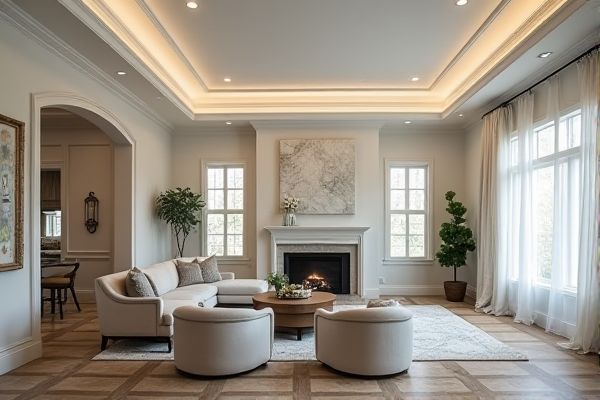
Tray ceilings feature a single recessed central panel that adds subtle depth and elegance to a room, while coffered ceilings consist of multiple sunken panels arranged in a grid pattern, creating a more dramatic and architectural appearance. Discover the key differences, benefits, and design ideas to choose the perfect ceiling style for your space in the rest of this article.
Table of Comparison
| Feature | Tray Ceiling | Coffered Ceiling |
|---|---|---|
| Design | Recessed central section creating a step effect | Grid pattern with sunken panels framed by beams |
| Visual Impact | Adds height and depth, elegant & subtle | Strong architectural statement, detailed & classic |
| Material | Drywall, plaster, or wood trim | Wood beams or MDF panels commonly used |
| Cost | Moderate installation cost | Higher cost due to complexity and materials |
| Installation Time | Faster to install compared to coffered | Longer installation due to intricate design |
| Lighting Options | Recessed or perimeter lighting common | Integrated lighting within panels or beams possible |
| Best For | Modern and transitional homes | Traditional and formal interiors |
Understanding Tray Ceilings
Tray ceilings feature a central section that is recessed or raised, creating a layered effect that adds depth and architectural interest to a room. This design enhances natural light by drawing the eye upward, often complemented by crown molding or subtle lighting to highlight the ceiling's contours. Popular in modern and traditional interiors, tray ceilings offer a sophisticated yet understated alternative to more elaborate ceiling designs like coffered ceilings.
What Is a Coffered Ceiling?
A coffered ceiling features a grid of recessed panels, often in a square or rectangular pattern, adding depth and architectural interest to any room. This design enhances your space by creating a visually appealing texture that also improves acoustics. Compared to tray ceilings, coffered ceilings emphasize geometric precision and intricate detailing, offering a more traditional and luxurious aesthetic.
Design Differences: Tray vs Coffered Ceilings
Tray ceilings feature a single recessed central panel bordered by a flat, raised perimeter, creating a clean, layered look that adds height and elegance to a room. Coffered ceilings consist of a grid of recessed panels, often square or rectangular, framed by beams that form a pattern, delivering a more intricate and architectural aesthetic with added texture and depth. Your choice depends on whether you prefer the subtle sophistication of a tray ceiling or the bold, detailed design of a coffered ceiling.
Aesthetic Impact on Interior Spaces
Tray ceilings create a subtle, layered effect that adds depth and dimension to interior spaces, making rooms appear taller and more spacious. Coffered ceilings feature a grid pattern of recessed panels that produce a more intricate, architectural statement, enhancing elegance and texture. Both ceiling styles significantly elevate aesthetic appeal but differ in visual complexity and style influence.
Architectural Styles and Ceiling Compatibility
Tray ceilings, featuring a single recessed central panel, complement modern, transitional, and traditional architectural styles by adding subtle depth and dimension without overwhelming the space. Coffered ceilings consist of multiple recessed panels often arranged in a grid pattern, aligning well with classical, Georgian, and Renaissance styles due to their intricate detailing and formal appearance. Both ceiling types enhance room height perception but vary in compatibility, with tray ceilings suiting minimalist interiors and coffered ceilings pairing best with ornate, historic designs.
Installation Process: Tray vs Coffered Ceilings
Tray ceiling installation involves framing a recessed central section that can be smoothly integrated into existing ceiling structures, making it relatively straightforward with fewer materials and less labor. Coffered ceilings require precise measurements and assembly of multiple grid-like beams or panels, demanding skilled craftsmanship for alignment and finishing. Your choice impacts complexity and cost, with tray ceilings typically offering easier installation while coffered ceilings provide a more intricate and decorative architectural element.
Cost Comparison and Budget Considerations
Tray ceilings typically cost less than coffered ceilings, with prices ranging from $1,200 to $3,500 for installation, while coffered ceilings can cost between $4,000 and $10,000 or more due to their intricate design and additional labor requirements. Your budget should account for materials such as wood or drywall, along with potential structural modifications, which can significantly influence the final price. Choosing between the two depends on balancing your aesthetic preferences with budget constraints and long-term value.
Maintenance and Durability Factors
Tray ceilings typically require less maintenance due to their simpler design with fewer joints and surfaces, reducing dust accumulation and minimizing repainting needs. Coffered ceilings, with their intricate sunken panels and moldings, demand more frequent cleaning and occasional touch-ups to preserve the detailed craftsmanship and prevent damage from dust and moisture. When considering durability, tray ceilings offer robust structural integrity with easier repairs, while coffered ceilings may require professional upkeep to maintain their aesthetic appeal and prevent warping over time.
Lighting Options for Each Ceiling Type
Tray ceilings offer versatile lighting options such as recessed lights and LED strips hidden within the recessed layers, creating soft, indirect lighting that enhances room depth. Coffered ceilings accommodate pendant lights or chandeliers within the grid pattern, highlighting the architectural details while allowing for direct illumination. Both ceiling types benefit from integrated cove lighting, but coffered ceilings often provide more opportunities for spotlighting individual panels.
Choosing the Right Ceiling for Your Home
Tray ceilings create an elegant, recessed centerpiece that adds depth without overwhelming your space, making them ideal for modern or transitional homes. Coffered ceilings, featuring a grid of recessed panels, offer a classic, architectural look that enhances formal rooms with a sense of sophistication and texture. Choosing the right ceiling depends on your home's style and ceiling height, ensuring your design complements your overall aesthetic while enhancing room dimensions.
 homyna.com
homyna.com